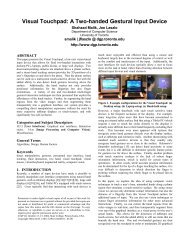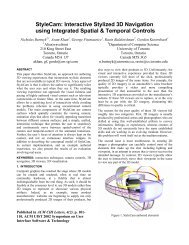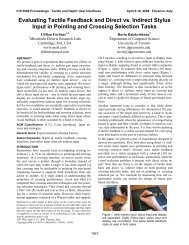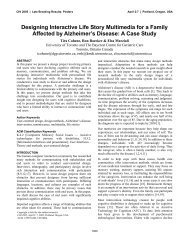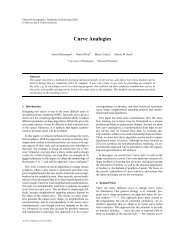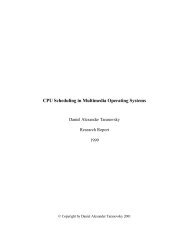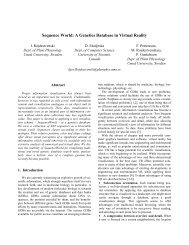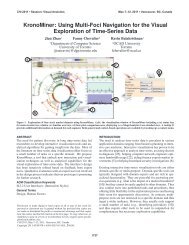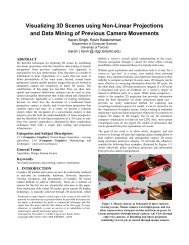Automatic Non-Rigid 3D Modeling from Video - University of Toronto ...
Automatic Non-Rigid 3D Modeling from Video - University of Toronto ...
Automatic Non-Rigid 3D Modeling from Video - University of Toronto ...
You also want an ePaper? Increase the reach of your titles
YUMPU automatically turns print PDFs into web optimized ePapers that Google loves.
<strong>Automatic</strong> <strong>Non</strong>-<strong>Rigid</strong> <strong>3D</strong> <strong>Modeling</strong> <strong>from</strong> <strong>Video</strong><br />
Lorenzo Torresani 1 and Aaron Hertzmann 2<br />
1 Stanford <strong>University</strong>, Stanford, CA, USA<br />
ltorresa@cs.stanford.edu<br />
2 <strong>University</strong> <strong>of</strong> <strong>Toronto</strong>, <strong>Toronto</strong>, ON, Canada<br />
hertzman@dgp.toronto.edu<br />
Abstract. We present a robust framework for estimating non-rigid <strong>3D</strong><br />
shape and motion in video sequences. Given an input video sequence, and<br />
a user-specified region to reconstruct, the algorithm automatically solves<br />
for the <strong>3D</strong> time-varying shape and motion <strong>of</strong> the object, and estimates<br />
which pixels are outliers, while learning all system parameters, including<br />
a PDF over non-rigid deformations. There are no user-tuned parameters<br />
(other than initialization); all parameters are learned by maximizing the<br />
likelihood <strong>of</strong> the entire image stream. We apply our method to both rigid<br />
and non-rigid shape reconstruction, and demonstrate it in challenging<br />
cases <strong>of</strong> occlusion and variable illumination.<br />
1 Introduction<br />
Reconstruction <strong>from</strong> video promises to produce high-quality <strong>3D</strong> models for many<br />
applications, such as video analysis and computer animation. Recenly, several<br />
“direct” methods for shape reconstruction <strong>from</strong> video sequences have been demonstrated<br />
[1–3] that can give good <strong>3D</strong> reconstructions <strong>of</strong> non-rigid <strong>3D</strong> shape, even<br />
<strong>from</strong> single-view video. Such methods estimate shape by direct optimization<br />
with respect to raw image data, thus avoiding the difficult problem <strong>of</strong> tracking<br />
features in advance <strong>of</strong> reconstruction. However, many difficulties remain for developing<br />
general-purpose video-based reconstruction algorithms. First, existing<br />
algorithms make the restrictive assumption <strong>of</strong> color constancy, that object features<br />
appear the same in all views. Almost all sequences <strong>of</strong> interest violate this<br />
assumption at times, such as with occlusions, lighting changes, motion blur, and<br />
many other common effects. Second, non-rigid shape reconstruction requires a<br />
number <strong>of</strong> regularization parameters (or, equivalently, prior distributions), due<br />
to fundamental ambiguities in non-rigid reconstruction [4, 5], and to handle noise<br />
and prevent over-fitting. Such weights must either be tuned by hand (which is<br />
difficult and inaccurate, especially for models with many parameters) or learned<br />
<strong>from</strong> annotated training data (which is <strong>of</strong>ten unavailable, or inappropriate to<br />
the target data).<br />
In this paper, we describe an algorithm for robust non-rigid shape reconstruction<br />
<strong>from</strong> uncalibrated video. Our general approach is to pose shape reconstruction<br />
as a maximum likelihood estimation problem, to be optimized with<br />
respect to the entire input video sequence. We solve for <strong>3D</strong> time-varying shape,
2 L. Torresani and A. Hertzmann<br />
correspondence, and outlier pixels, while simultaneously solving for all weighting/PDF<br />
parameters. By doing so, we exploit the general property <strong>of</strong> Bayesian<br />
learning that all parameters may be estimated by maximizing the posterior distribution<br />
for a suitable model. No prior training data or parameter tuning is<br />
required. This general methodology — <strong>of</strong> simultaneously solving for shape while<br />
learning all weights/PDF parameters — has not been applied to <strong>3D</strong> shape reconstruction<br />
<strong>from</strong> video, and has only rarely been exploited in computer vision<br />
in general (one example is [6]).<br />
This paper begins with a general framework for robust shape reconstruction<br />
<strong>from</strong> video. This model is based on robust statistics: all violations <strong>of</strong> color<br />
constancy are modeled as outliers. Unlike robust tracking algorithms, we solve<br />
for shape globally over an entire sequence, allowing us to handle cases where<br />
many features are completely occluded in some frames. (A disadvantage <strong>of</strong> our<br />
approach is that it cannot currently be applied to one-frame-at-a-time tracking).<br />
We demonstrate sequences for which previous global reconstruction methods fail.<br />
For example, previous direct methods require that all feature points be visible<br />
in all video frames, i.e. all features are visible in a single “reference frame;” our<br />
method relaxes this assumption and allows sequences for which no single “reference<br />
frame” exists. We also show examples where existing techniques fail due to<br />
local changes in lighting and shape. Our method is based on the EM algorithm<br />
for robust outlier detection. Additionally, we show how to simultaneously solve<br />
for the outlier probabilities for the target sequence.<br />
We demonstrate the reconstruction framework in the case <strong>of</strong> rigid motion<br />
under weak perspective projection, and non-rigid shape under orthographic projection.<br />
In the latter case, we do not assume that the non-rigid geometry is<br />
known in advance. Separating non-rigid deformation <strong>from</strong> rigid motion is ambiguous<br />
without some assumptions about deformation [4, 5]. Rather than specify<br />
the parameters <strong>of</strong> a shape prior in advance, our algorithm learns a shape PDF<br />
simultaneously with estimating correspondence, <strong>3D</strong> shape reconstruction, and<br />
outliers.<br />
1.1 Relation to Previous Work<br />
We build on recent techniques for exploiting rank constraints on optical flow in<br />
uncalibrated single-view video. Conventional optical flow algorithms use only local<br />
information; namely, every track in every frame is estimated separately [7, 8].<br />
In contrast, so-called “direct methods” optimize directly with respect to the raw<br />
image sequence [9]. Irani [1] treated optical flow in rigid <strong>3D</strong> scenes as a global<br />
problem, combining information <strong>from</strong> the entire sequence — along with rank<br />
constraints on motion — to yield better tracking. Bregler et al. [10] describe an<br />
algorithm for solving for non-rigid <strong>3D</strong> shape <strong>from</strong> known point tracks. Extending<br />
these ideas, Torresani et al. [2, 11] and Brand [3] describe tracking and reconstruction<br />
algorithms that solve for <strong>3D</strong> shape and motion <strong>from</strong> sequences, even<br />
for non-rigid scenes. Note that adding robustness to the above methods is nontrivial,<br />
since this would require defining a unified objective function for tracking<br />
and reconstruction that is not present in the previous work. Furthermore, one
<strong>Automatic</strong> <strong>Non</strong>-<strong>Rigid</strong> <strong>3D</strong> <strong>Modeling</strong> <strong>from</strong> <strong>Video</strong> 3<br />
must introduce a large number <strong>of</strong> hand-tuned weighting and regularization constraints,<br />
especially for non-rigid motion, for which reconstruction is ill-posed<br />
without some form <strong>of</strong> regularization [4, 5]. In our paper, we show how to cast<br />
the problem <strong>of</strong> estimating <strong>3D</strong> shape and motion <strong>from</strong> video sequences as optimization<br />
<strong>of</strong> a well-defined likelihood function. This framework allows several<br />
extensions: our method automatically detects outliers, and all regularization parameters<br />
are automatically learned via Bayesian learning. Our non-rigid model<br />
incorporates our previous work on non-rigid structure-<strong>from</strong>-motion [5], in which<br />
reliable tracking data was assumed to be available in advance.<br />
A common approach to acquiring rigid shape <strong>from</strong> video is to separate feature<br />
selection, outlier rejection, and shape reconstruction into a series <strong>of</strong> stages,<br />
each <strong>of</strong> which has a separate optimization process (e.g. [12]). Dellaert et al. [13]<br />
solve for rigid shape while detecting outliers, assuming that good features can<br />
be located in advance. The above methods assume that good features can be detected<br />
in each frame by a feature detector, and that noise/outlier parameters are<br />
known in advance. In contrast to these methods, we optimize the reconstruction<br />
directly with respect to the video sequence.<br />
Robust algorithms for tracking have been widely explored in local tracking<br />
(e.g. [14–16]). Unlike local robust methods, our method can handle features that<br />
are completely occluded, by making use <strong>of</strong> global constraints on motion. Similar<br />
to Jepson et al. [16], we also learn the parameters at the same time as tracking,<br />
rather than assuming that they are known a priori. Our outlier model is closely<br />
related to layer-based motion segmentation algorithms [6, 17, 18], which are also<br />
<strong>of</strong>ten applied globally to a sequence. We use the outlier model to handle general<br />
violations <strong>of</strong> color constancy, rather than to specifically model multiple layers.<br />
2 Robust Shape Reconstruction Framework<br />
We now describe our general framework for robust shape reconstruction <strong>from</strong><br />
uncalibrated video. We then specialize this framework to rigid <strong>3D</strong> motion in<br />
Section 3, and to non-rigid motion in Section 4.<br />
2.1 Motion model<br />
We assume that <strong>3D</strong> shape can be described in terms <strong>of</strong> the <strong>3D</strong> coordinates<br />
s j,t = [X j,t , Y j,t , Z j,t ] T <strong>of</strong> J scene points, over T time steps. The parameter<br />
j indexes over points in the model, and t over time. We collect these points<br />
in a matrix S t = [s 1,t , ..., s J,t ]. We parameterize <strong>3D</strong> shape with a function as<br />
S t = Γ (z t ; ψ), where z t is a hidden random variable describing the shape at<br />
each time t, with a prior p(z t ); ψ are shape model parameters. The details <strong>of</strong><br />
these functions depend on the application. For example, in the case <strong>of</strong> rigid shape<br />
(Section 3), we use Γ (z t ; ψ) = ¯S, i.e. the shape stays fixed at a constant value ¯S,<br />
and ψ = {¯S}. For non-rigid shape (Section 4), Γ (z t ; ψ) is a linear combination<br />
<strong>of</strong> basis shapes, determined by the time-varying weights z t ; ψ contains the shape<br />
basis.
4 L. Torresani and A. Hertzmann<br />
Additionally, we define a camera model Π. At a given time t, point j projects<br />
to a 2D position p j,t = [x j,t , y j,t ] T = Π(s j,t ; ξ t ), where ξ t are the time-varying<br />
parameters <strong>of</strong> the camera model. For example, ξ t might define the position and<br />
orientation <strong>of</strong> the camera with respect to the object.<br />
In cases when the object is undergoing rigid motion, we subsume it in the<br />
rigid motion <strong>of</strong> the camera. This applies in both the case <strong>of</strong> rigid shape and nonrigid<br />
shape. In the non-rigid case, we can generally think <strong>of</strong> the object’s motion<br />
as consisting <strong>of</strong> a rigid component plus a non-rigid deformation. For example, a<br />
person’s head can move rigidly (e.g. turning left or right) while deforming (due to<br />
changing facial expressions). One might wish to separate rigid object motion <strong>from</strong><br />
rigid camera motion in other applications, such as under perspective projection.<br />
2.2 Image model<br />
We now introduce a generative model for video sequences, given the motion<br />
<strong>of</strong> the 2D point tracks p j,t . Individual images in a video sequence are created<br />
<strong>from</strong> the 2D points. Ideally, the window <strong>of</strong> pixels around each point p j,t should<br />
remain constant over time; however, this window may be corrupted by noise and<br />
outliers. Let w be an index over a pixel window, so that I w (p j,t ) is the intensity<br />
<strong>of</strong> a pixel in the window 1 <strong>of</strong> point j in frame t. This pixel intensity should ideally<br />
be a constant Īw,j; however, it will be corrupted by Gaussian noise with variance<br />
σ 2 . Moreover, it may be replaced by an outlier, with probability 1−τ. We define<br />
a hidden variable W w,j,t so that W w,j,t = 0 if the pixel is replaced by an outlier,<br />
and W w,j,t = 1 if it is valid. The complete PDF over individual pixels in a<br />
window is given by:<br />
p(W w,j,t = 1) = τ (1)<br />
p(I w (p j,t )|W w,j,t = 1, p j,t , Īw,j, σ 2 ) = N (I w (p j,t )|Īw,j; σ 2 ) (2)<br />
p(I w (p j,t )|W w,j,t = 0, p j,t , Īw,j, σ 2 ) = c (3)<br />
where N (I w (p j,t )|Īw,j; σ 2 ) denotes a 1D Gaussian distribution with mean Īw,j<br />
and variance σ 2 , and c is a constant corresponding to the uniform distribution<br />
over the range <strong>of</strong> valid pixel intensities. The values Īw,j are determined by the<br />
corresponding pixel in the reference frame.<br />
For convenience, we do not model the appearance <strong>of</strong> video pixels that do not<br />
appear near 2D points, or correlations between pixels when windows overlap.<br />
2.3 Problem statement<br />
Given a video sequence I and 2D point positions specified in some reference<br />
frames, we would like to estimate the positions <strong>of</strong> the points in all other frames,<br />
and, additionally, learn the <strong>3D</strong> shape and associated parameters.<br />
1 In other words, I w(p j,t) = I (t) (p j,t + d w) where I (t) is the image at time t, and d w<br />
represents the <strong>of</strong>fset <strong>of</strong> point w inside the window.
<strong>Automatic</strong> <strong>Non</strong>-<strong>Rigid</strong> <strong>3D</strong> <strong>Modeling</strong> <strong>from</strong> <strong>Video</strong> 5<br />
We propose to solve this estimation problem by maximizing the likelihood <strong>of</strong><br />
the image sequence given the model. We encapsulate the parameters for the image,<br />
shape, and camera model into the parameter vector θ = {Ī, σ2 , τ, ψ, ξ 1 , ..., ξ T }.<br />
The likelihood itself marginalizes over the hidden variables W w,j,t and z t . Consequently,<br />
our goal is to solve for θ to maximize<br />
p(I|θ) = ∏ p(I w (p j,t )|θ) = ∏ ∫<br />
∑<br />
p(I, z t , W w,j,t |θ)dz t (4)<br />
w,j,t<br />
w,j,t z t<br />
W w,j,t∈{0,1}<br />
(We have replaced I w (p j,t ) with I for brevity). In other words, we wish to solve<br />
for the camera motion, shape PDF, and outlier distribution <strong>from</strong> the video sequence<br />
I, averaging over the unknown shapes and outliers.<br />
2.4 Variational bound<br />
In order to optimize Equation 4, we use an approach based on variational learning<br />
[19]. Specifically, we introduce a distribution Q(W w,j,t , z t ) to approximate<br />
the distribution over the hidden parameters at time t, and then apply Jensen’s<br />
inequality to derive an upper bound on the negative log likelihood: 2<br />
− ln p(I|θ) = − ln ∏ ∫<br />
∑<br />
p(I, z t , W w,j,t |θ)dz t (5)<br />
w,j,t z t<br />
= − ∑ ∫<br />
ln<br />
w,j,t<br />
≤ − ∑ ∫<br />
w,j,t z t<br />
W w,j,t∈{0,1}<br />
∑<br />
z t W w,j,t∈{0,1}<br />
∑<br />
W w,j,t∈{0,1}<br />
p(I, z t , W w,j,t |θ) Q(W w,j,t, z t )<br />
Q(W w,j,t , z t ) dz t (6)<br />
Q(W w,j,t , z t ) ln p(I, z t, W w,j,t |θ)<br />
dz t (7)<br />
Q(W w,j,t , z t )<br />
We can minimize the negative log likelihood by minimizing Equation 7 with<br />
respect to θ and Q. Unfortunately, even representing the optimal distribution<br />
Q(W w,j,t , z t ) would be intractable, due to the large number <strong>of</strong> point tracks.<br />
To make it manageable, we represent the distribution Q with a factored form:<br />
Q(W w,j,t , z t ) = q(z t )q(W w,j,t ), where q(z t ) is a distribution over z t for each<br />
frame, and q(W w,j,t ) is a distribution over whether each pixel (w, j, t) is valid<br />
or an outlier. The distribution q(z t ) can be thought <strong>of</strong> as approximating to<br />
p(z t |I, θ), and q(W w,j,t ) approximates the distribution p(W w,j,t |I, θ). Substituting<br />
the factored form into Equation 7 gives the variational free energy (VFE)<br />
F(θ, q):<br />
F(θ, q) = − ∑ w,j,t<br />
∫<br />
∑<br />
z t W w,j,t∈{0,1}<br />
q(W w,j,t )q(z t ) ln p(I, z t, W w,j,t |θ)<br />
q(W w,j,t )q(z t ) dz t (8)<br />
In order to estimate shape and motion <strong>from</strong> video, our new goal is to minimize<br />
F with respect to θ and q over all points j and frames t. For brevity, we write<br />
2 We require that ∏ w,j,t<br />
∫z t<br />
∑W w,j,t ∈{0,1}<br />
Q(Ww,j,t, zt) = 1, in order for Jensen’s<br />
inequality to hold.
6 L. Torresani and A. Hertzmann<br />
γ w,j,t ≡ q(W w,j,t = 1). Substituting the image model <strong>from</strong> Section 2.2 and<br />
defining the expectation E q(zt)[f(z t )] ≡ ∫ q(z t )f(z t )dz t gives<br />
F(θ, q, γ) = ∑ w,j,t<br />
γ w,j,t E q(zt)[(I w (p t,j ) − Īw,j) 2 ]/(2σ 2 ) + ln √ 2πσ 2 ∑ w,j,t<br />
γ w,j,t<br />
−NJ ∑ t<br />
E q(zt)[ln p(z t )] − ln c ∑ w,j,t<br />
(1 − γ w,j,t ) − ln τ ∑ w,j,t<br />
γ w,j,t<br />
− ln(1 − τ) ∑ w,j,t<br />
∑<br />
(1 − γ w,j,t ) + NJ ∑ t<br />
w,j,t(1 − γ w,j,t ) ln(1 − γ w,j,t ) + ∑ w,j,t<br />
E q(zt)[ln q(z t )] +<br />
γ w,j,t ln γ w,j,t + constants (9)<br />
where N is the number <strong>of</strong> pixels in a window. Although there are many terms in<br />
this expression, most terms have a simple interpretation. Specifically, we point<br />
out that the first term is a weighted image matching term: for each pixel, it<br />
measures the expected reconstruction error <strong>from</strong> comparing an image pixel to<br />
its mean intensity Īw,j, weighted by the likelihood γ w,j,t that the pixel is valid.<br />
2.5 Generalized EM algorithm<br />
We optimize the VFE using a generalized EM algorithm. In the E-step we keep<br />
the model parameters fixed and update our estimate <strong>of</strong> the hidden variable<br />
distributions. The update rule for q(z t ) will depend on the particular motion<br />
model specified by Γ . The distribution γ w,j,t (which indicates whether pixel<br />
(w, j, t) is an outlier) is estimated as:<br />
α 0 = p(I w (p j,t )|W w,j,t = 0, p j,t , θ)p(W w,j,t = 0|θ) = (1 − τ)c (10)<br />
α 1 = p(I w (p j,t )|W w,j,t = 1, p j,t , θ)p(W w,j,t = 1|θ) (11)<br />
τ<br />
= √<br />
2πσ<br />
2 e−E q(z t )[(I w(p t,j)−Īw,j)2 ]/(2σ 2 )<br />
(12)<br />
Then, using Bayes’ Rule, we have the E-step for γ w,j,t :<br />
γ w,j,t ← α 1 /(α 0 + α 1 ) (13)<br />
In the generalized M-step, we solve for optical flow and <strong>3D</strong> shape given the<br />
outlier probabilities γ w,j,t . The outlier probabilities provide a weighting function<br />
for tracking and reconstruction: pixels likely to be valid are given more weight.<br />
Let p 0 j,t represent the current estimate <strong>of</strong> p j,t at a step during the optimization.<br />
To solve for the motion parameters that define p j,t , we linearize the target image<br />
around p 0 j,t : I w (p j,t ) ≈ I w (p 0 j,t) + ∇I T w (p j,t − p 0 j,t) (14)<br />
where ∇I w denotes a 2D vector <strong>of</strong> image derivatives at I w (p 0 j,t ). One such linearization<br />
is applied for every pixel w in every window j for every frame t at<br />
every iteration <strong>of</strong> the algorithm.
<strong>Automatic</strong> <strong>Non</strong>-<strong>Rigid</strong> <strong>3D</strong> <strong>Modeling</strong> <strong>from</strong> <strong>Video</strong> 7<br />
Substituting Equation 14 into the first term <strong>of</strong> the VFE (Equation 9) yields<br />
the following quadratic energy function for the motion: 3<br />
∑<br />
w,j,t<br />
where<br />
γ w,j,t<br />
2σ 2 E q(z t)[(I w (p t,j ) − Īw,j) 2 ] ≈ ∑ j,t<br />
E q(zt)[(p j,t − ˆp j,t ) T e j,t (p j,t − ˆp j,t )]<br />
(15)<br />
e j,t = 1 ∑<br />
2σ 2 γ w,j,t ∇I w ∇Iw T (16)<br />
w<br />
ˆp j,t = p 0 j,t + 1<br />
2σ 2 e−1 j,t<br />
∑<br />
γ w,j,t (Īw,j − I w (p 0 j,t))∇I w (17)<br />
w<br />
Hence, optimizing the shape and motion with respect to the image is equivalent<br />
to solving the structure-<strong>from</strong>-motion problem <strong>of</strong> fitting the “virtual point tracks”<br />
ˆp j,t , each <strong>of</strong> which has uncertainty specified by a 2×2 covariance matrix e −1<br />
j,t . In<br />
the next sections, we will outline the details <strong>of</strong> this optimization for both rigid<br />
and non-rigid motion.<br />
The noise variance and the outlier prior probability are also updated in the<br />
M-step, by optimizing F(θ, q, γ) for τ and σ 2 :<br />
τ ← ∑ w,j<br />
σ 2 ← ∑ w,j,t<br />
γ w,j,t /(JNT ) (18)<br />
γ w,j,t E q(zt)[(I w (p j,t ) − Īw,j) 2 ]/ ∑ w,j<br />
γ w,j,t (19)<br />
The σ 2 update can be computed with Equation 15. These updates can be interpreted<br />
as the expected percentage <strong>of</strong> outliers, and the expected image variance,<br />
respectively.<br />
3 <strong>Rigid</strong> <strong>3D</strong> Shape Reconstruction <strong>from</strong> <strong>Video</strong><br />
The general-purpose framework presented in the previous section can be specialized<br />
to a variety <strong>of</strong> projection and motion models. In this section we outline<br />
the algorithm in the case <strong>of</strong> rigid motion under weak orthographic projection.<br />
This projection model can be described in terms <strong>of</strong> parameters ξ t = {α t , R t , t t }<br />
and projection function<br />
Π(s j,t ; {α t , R t , t t }) = α t R t s j,t + t t (20)<br />
where R t is a 2 × 3 matrix combining rotation with orthographic projection,<br />
t t is a 2 × 1 translation vector and α t is a scalar implicitly representing the<br />
weak perspective scaling (f/Z avg ). The <strong>3D</strong> shape <strong>of</strong> the object is assumed to<br />
3 The linearized VFE is not guaranteed to bound the negative log-likelihood, but<br />
provides a local approximation to the actual VFE.
8 L. Torresani and A. Hertzmann<br />
remain constant over the entire sequence and, thus, we can use as our shape<br />
model Γ (ψ) = ¯S, without introducing a time-dependent latent variable z t . In<br />
other words, the model for 2D points is p j,t = α t R t¯s j,t + t t .<br />
For this case, the objective function in Equation 9 reduces to:<br />
F(θ, R, t, γ) = ∑ w,j,t<br />
γ w,j,t (I w (p t,j ) − Īw,j) 2 /(2σ 2 ) + ∑ w,j,t<br />
γ w,j,t ln √ 2πσ 2<br />
− ∑ γ w,j,t ln τ − ∑ − γ w,j,t ) ln c(1 − τ)<br />
w,j,t<br />
w,j,t(1<br />
+ ∑ γ w,j,t ln γ w,j,t + ∑ − γ w,j,t ) ln(1 − γ w,j,t ) (21)<br />
w,j,t<br />
w,j,t(1<br />
Note that, in the case where all pixels are completely reliable (all γ w,j,t = 1), this<br />
reduces to a global image matching objective function. Again, we can rewrite<br />
the first term in the free energy in terms <strong>of</strong> virtual point tracks ˆp j,t and covariances,<br />
as in Equation 15. Covariance-weighted factorization [20] can then be<br />
applied to minimize this objective function to estimate the rigid shape ¯S and<br />
the motion parameters R t , t t and α t for all frames. Orthonormality constraints<br />
on rotation matrices are enforced in a fashion similar to [21]. To summarize the<br />
entire algorithm, we alternate between optimizing each <strong>of</strong> γ w,j,t , R t , t t , α t , τ,<br />
and σ 2 . Between each <strong>of</strong> the updates, ˆp j,t and e j,t are recomputed.<br />
Implementation details. We initialize our algorithm using conventional coarseto-fine<br />
Lucas-Kanade tracking [8]. Since the conventional tracker will diverge if<br />
applied to the entire sequence at once, we correct the motion every few frames by<br />
applying our generalized EM algorithm over the subsequence thus far initialized.<br />
This process is repeated until we reach the end <strong>of</strong> the sequence. We refine this<br />
estimate by additional EM iterations. The values <strong>of</strong> σ 2 and τ are initially held<br />
fixed at 10 and 0.3, respectively. They are then updated in every M-step after<br />
the first few iterations.<br />
Experiments. We applied the robust reconstruction algorithm to a sequence<br />
assuming rigid motion under weak perspective projection. This video contains<br />
100 frames <strong>of</strong> mostly-rigid head/face motion. The sequence is challenging due to<br />
the low resolution and low frame rate (15 fps). In this example, there is no single<br />
frame in which feature points <strong>from</strong> both sides <strong>of</strong> the face are clearly visible, so<br />
existing global techniques cannot be applied.<br />
To test our algorithm, we manually indicated regions-<strong>of</strong>-interest in two reference<br />
frames, <strong>from</strong> which 45 features were automatically selected (Figure 1(a)).<br />
Points <strong>from</strong> the left side <strong>of</strong> the subject’s face are occluded for more than 50% <strong>of</strong><br />
the sequence. Some <strong>of</strong> the features on the left side <strong>of</strong> the face are lost or incorrectly<br />
tracked by local methods after just four frames <strong>from</strong> the reference image<br />
where they were selected. Within 14 frames, all points <strong>from</strong> the left side are<br />
completely invisible, and thus would be lost by conventional techniques. With<br />
robust reconstruction, our algorithm successfully tracks all features, making use<br />
<strong>of</strong> learned geometry constraints to fill in missing features (Figure 2).
<strong>Automatic</strong> <strong>Non</strong>-<strong>Rigid</strong> <strong>3D</strong> <strong>Modeling</strong> <strong>from</strong> <strong>Video</strong> 9<br />
(a)<br />
(b)<br />
Fig. 1. Reference frames. Regions <strong>of</strong> interest were selected manually, and individual<br />
point locations selected automatically using Shi and Tomasi’s method [22]. Note that,<br />
in the first sequence, most points are clearly visible in only one reference frame. (Refer<br />
to the electronic version <strong>of</strong> this paper to view the points in color.)<br />
(a)<br />
(b)<br />
Frame 2 Frame 60 Frame 100<br />
Fig. 2. (a) Rank-constrained tracking <strong>of</strong> the rigid sequence without outlier detection<br />
(i.e. using τ = 0), using the reference frames shown in Figure 1(a). Tracks on occluded<br />
portions <strong>of</strong> the face are consistently lost. (b) Robust, rank-constrained tracking applied<br />
to the same sequence. Tracks are colored according to the average value <strong>of</strong> γ w,j,t for the<br />
pixels in the track’s window: green for completely valid pixels, and red for all outliers.<br />
4 <strong>Non</strong>-<strong>Rigid</strong> <strong>3D</strong> Shape Reconstruction <strong>from</strong> <strong>Video</strong><br />
We now apply our framework to the case where <strong>3D</strong> shape consists <strong>of</strong> both rigid<br />
motion and non-rigid deformation, and show how to solve for the deforming<br />
shape <strong>from</strong> video, while detecting outliers and solving for the shape and outlier<br />
PDFs. Our approach builds on our previous algorithm for non-rigid structure<strong>from</strong>-motion<br />
[5], which, as previously demonstrated on toy examples, yields much<br />
better reconstructions than applying a user-defined regularization.
10 L. Torresani and A. Hertzmann<br />
We assume that the nonrigid shape S t at time t can be described as a “shape<br />
average” ¯S plus a linear combination <strong>of</strong> K basis shapes V k :<br />
K∑<br />
S t = Γ (z t ; ψ) = ¯S + V k z k,t (22)<br />
k=1<br />
where k indexes elements <strong>of</strong> z t and ψ = {¯S, V 1 , ..., V K }. The scalar weights z k,t<br />
indicate the deformation in each frame t. Together, ¯S and V k are referred to as<br />
the shape basis. The z t are Gaussian hidden variables with zero mean and unit<br />
variance (p(z t ) = N (z t |0; I)). With z t treated as a hidden variable, this model<br />
is a factor analyzer, and the distribution over shape p(S t ) is Gaussian. See [5]<br />
for a more detailed discussion <strong>of</strong> this model. Scene points are viewed under<br />
orthographic projection according to the model: Π(s j,t ; {R t , t t }) = R t s j,t + t t .<br />
The imaging model is the same as described in Section 2.2. We encapsulate the<br />
model in the parameter vector θ = {Ī, σ2 , τ, R 1 , ..., R T , t 1 , ..., t T , ¯S, V 1 , ..., V K }.<br />
We optimize the VFE by alternating updates <strong>of</strong> each <strong>of</strong> the parameters. Each<br />
update entails setting ∂F to zero with respect to each <strong>of</strong> the parameters; e.g. t t<br />
is updated by solving ∂F<br />
∂t t<br />
= 0. The algorithm is given in the appendix.<br />
Experiments. We tested our integrated <strong>3D</strong> reconstruction algorithm on a challenging<br />
video sequence <strong>of</strong> non-rigid human motion. The video consists <strong>of</strong> 660<br />
frames recorded in our lab with a consumer digital video camera and contains<br />
non-rigid deformations <strong>of</strong> a human torso. Although most <strong>of</strong> the features tracked<br />
are characterized by distinctive 2D texture, their local appearance changes considerably<br />
during the sequence due to occlusions, shape deformations, varying<br />
illumination in patches, and motion blur. More than 25% <strong>of</strong> the frames contain<br />
occluded features, due to arm motion and large torso rotations. 77 features<br />
were selected automatically in the first frame using the criterion described by<br />
Shi and Tomasi [22]. Figure 1(b) shows their initial locations in the reference<br />
frame. The sequence was initially processed assuming K = 1 (corresponding<br />
to rigid motion plus a single mode <strong>of</strong> deformation), and increased to K = 2<br />
during optimization. Estimated positions <strong>of</strong> features with and without robustness<br />
are shown in Figure 3. As shown in Figure 3(a), tracking without outlier<br />
detection fails to converge to a reasonable result, even if initialized with<br />
the results <strong>of</strong> the robust algorithm. <strong>3D</strong> reconstructions <strong>from</strong> our algorithm<br />
are shown in Figure 4(b). The resulting <strong>3D</strong> shape is highly detailed, even for<br />
occluded regions. For comparison, we applied robust rank-constrained tracking<br />
to solve for maximum likelihood z t and θ, followed by applying the EM-<br />
Gaussian algorithm [5] to the recovered point tracks. Although the results are<br />
mostly reasonable, a few significant errors occur in an occluded region. Our algorithm<br />
avoids these errors, because it optimizes all parameters directly with<br />
respect to the raw image data. Additional results and visualizations are shown<br />
at http://movement.stanford.edu/automatic-nr-modeling/
<strong>Automatic</strong> <strong>Non</strong>-<strong>Rigid</strong> <strong>3D</strong> <strong>Modeling</strong> <strong>from</strong> <strong>Video</strong> 11<br />
(a)<br />
(b)<br />
Frame 325 Frame 388 Frame 528<br />
Fig. 3. (a) Rank-constrained tracking <strong>of</strong> the second sequence without outlier detection<br />
fails to converge to a reasonable result. Here we show that, even when initialized with<br />
the solution <strong>from</strong> the robust method, tracking without robustness causes the results to<br />
degrade. (b) Robust, rank-constrained tracking applied to the same sequence. Tracks<br />
are colored according to the average value <strong>of</strong> γ w,j,t for the pixels in the track’s window:<br />
green for completely valid pixels, and red for all outliers.<br />
(a)<br />
(b)<br />
Fig. 4. <strong>3D</strong> reconstruction comparison. (a) Robust covariance-weighted factorization,<br />
plus EM-Gaussian [5]. (b) Our result, using integrated non-rigid reconstruction. Note<br />
that even occluded areas are accurately reconstructed by the integrated solution.<br />
5 Discussion and future work<br />
We have presented techniques for tracking and reconstruction <strong>from</strong> video sequences<br />
that contain occlusions and other common violations <strong>of</strong> color constancy,<br />
as well as complicated non-rigid shape and unknown system parameters. Previously,<br />
tracking challenging footage with severe occlusions or non-rigid defor-
12 L. Torresani and A. Hertzmann<br />
Fig. 5. Tracking and <strong>3D</strong> reconstruction <strong>from</strong> a bullfight sequence, taken <strong>from</strong> the movie<br />
Talk To Her. (The camera is out-<strong>of</strong>-focus in the second image).<br />
mations could only be achieved with very strong shape and appearance models.<br />
We have shown how to track such difficult sequences without prior knowledge<br />
<strong>of</strong> appearance and dynamics.<br />
We expect that these techniques can provide a bridge to very practical tracking<br />
and reconstruction algorithms, by allowing one to model important variations<br />
in detail without having to model all other sources <strong>of</strong> non-constancy. There are<br />
a wide variety <strong>of</strong> possible extensions to this work, including: more sophisticated<br />
lighting models (e.g. [23]), layer-based decomposition (e.g. [6]), and temporal<br />
smoothness in motion and shape (e.g. [24, 5]).<br />
It would be straightforward to handle true perspective projection for rigid<br />
scenes in our framework, by performing bundle adjustment in the generalized<br />
M-step. Our model could also be learned incrementally in a real-time setting<br />
[16], although it would be necessary to bootstrap with a suitable initialization.<br />
Acknowledgements. This work arose <strong>from</strong> discussions with Chris Bregler.<br />
Thanks to Hrishikesh Deshpande for help with data capture, and to Kyros Kutulakos<br />
for discussion. Portions <strong>of</strong> this work were performed while LT was visiting<br />
New York <strong>University</strong>, and AH was at <strong>University</strong> <strong>of</strong> Washington. LT was supported<br />
by ONR grant N00014-01-1-0890 under the MURI program. AH was<br />
supported in part by UW Animation Research Labs, NSF grant IIS-0113007,<br />
the Connaught Fund, and an NSERC Discovery Grant.<br />
References<br />
1. Irani, M.: Multi-Frame Correspondence Estimation Using Subspace Constraints.<br />
Int. J. <strong>of</strong> Comp. Vision 48 (2002) 173–194<br />
2. Torresani, L., Yang, D., Alexander, G., Bregler, C.: Tracking and <strong>Modeling</strong> <strong>Non</strong>-<br />
<strong>Rigid</strong> Objects with Rank Constraints. In: Proc. CVPR. (2001)<br />
3. Brand, M.: Morphable <strong>3D</strong> models <strong>from</strong> video. In: Proc. CVPR. (2001)<br />
4. Soatto, S., Yezzi, A.J.: DEFORMOTION: Deforming Motion, Shape Averages, and<br />
the Joint Registration and Segmentation <strong>of</strong> Images. In: Proc. ECCV. Volume 3.<br />
(2002) 32–47<br />
5. Torresani, L., Hertzmann, A., Bregler, C.: Learning <strong>Non</strong>-<strong>Rigid</strong> <strong>3D</strong> Shape <strong>from</strong> 2D<br />
Motion. In: Proc. NIPS 16. (2003) To appear.<br />
6. Jojic, N., Frey, B.: Learning Flexible Sprites in <strong>Video</strong> Layers. In: Proc. CVPR.<br />
(2001)<br />
7. Horn, B.K.P.: Robot Vision. McGraw-Hill, New York, NY (1986)<br />
8. Lucas, B.D., Kanade, T.: An iterative image registration technique with an application<br />
to stereo vision. In: Proc. 7th IJCAI. (1981)
<strong>Automatic</strong> <strong>Non</strong>-<strong>Rigid</strong> <strong>3D</strong> <strong>Modeling</strong> <strong>from</strong> <strong>Video</strong> 13<br />
9. Irani, M., Anandan, P.: About Direct Methods. In: Vision Algorithms ’99. (2000)<br />
267–277 LNCS 1883.<br />
10. Bregler, C., Hertzmann, A., Biermann, H.: Recovering <strong>Non</strong>-<strong>Rigid</strong> <strong>3D</strong> Shape <strong>from</strong><br />
Image Streams. In: Proc. CVPR. (2000)<br />
11. Torresani, L., Bregler, C.: Space-Time Tracking. In: Proc. ECCV. Volume 1.<br />
(2002) 801–812<br />
12. Forsyth, D.A., Ponce, J.: Computer Vision: A Modern Approach. Prentice Hall<br />
(2003)<br />
13. Dellaert, F., Seitz, S.M., Thorpe, C.E., Thrun, S.: EM, MCMC, and Chain Flipping<br />
for Structure <strong>from</strong> Motion with Unknown Correspondence. Machine Learning 50<br />
(2003) 45–71<br />
14. Black, M.J., Anandan, P.: The robust estimation <strong>of</strong> multiple motions: Parametric<br />
and piecewise-smooth flow fields. Computer Vision and Image Understanding 63<br />
(1996) 75–104<br />
15. Jepson, A., Black, M.J.: Mixture models for optical flow computation. In: Proc.<br />
CVPR. (1993) 760–761<br />
16. Jepson, A.D., Fleet, D.J., El-Maraghi, T.F.: Robust Online Appearance Models<br />
for Visual Tracking. IEEE Trans. PAMI 25 (2003) 1296–1311<br />
17. Wang, J.Y.A., Adelson, E.H.: Representing moving images with layers. IEEE<br />
Trans. Image Processing 3 (1994) 625–638<br />
18. Weiss, Y., Adelson, E.H.: Perceptually organized EM: A framework for motion<br />
segmentation that combines information about form and motion. Technical Report<br />
TR 315, MIT Media Lab Perceptual Computing Section (1994)<br />
19. Jordan, M.I., Ghahramani, Z., Jaakkola, T.S., Saul, L.K.: An introduction to variational<br />
methods for graphical models. In Jordan, M.I., ed.: Learning in Graphical<br />
Models. Kluwer Academic Publishers (1998)<br />
20. Morris, D.D., Kanade, T.: A Unified Factorization Algorithm for Points, Line<br />
Segments and Planes with Uncertainty Models. In: Proc. ICCV. (1998) 696–702<br />
21. Tomasi, C., Kanade, T.: Shape and motion <strong>from</strong> image streams under orthography:<br />
A factorization method. Int. J. <strong>of</strong> Computer Vision 9 (1992) 137–154<br />
22. Shi, J., Tomasi, C.: Good Features to Track. In: Proc. CVPR. (1994) 593–600<br />
23. Zhang, L., Curless, B., Hertzmann, A., Seitz, S.M.: Shape and Motion under<br />
Varying Illumination: Unifying Structure <strong>from</strong> Motion, Photometric Stereo, and<br />
Multi-view Stereo. In: Proc. ICCV. (2003) 618–625<br />
24. Gruber, A., Weiss, Y.: Factorization with Uncertainty and Missing Data: Exploiting<br />
Temporal Coherence. In: Proc. NIPS 16. (2003) To appear.<br />
A<br />
<strong>Non</strong>-rigid reconstruction algorithm<br />
The non-rigid reconstruction algorithm <strong>of</strong> Section 4 alternates between optimizing<br />
the VFE with respect to each <strong>of</strong> the unknowns. The linearization in<br />
Equation 14 is used to make these updates closed-form. This linearization also<br />
means that the distribution q(z t ) is Gaussian. We represent it with the variables<br />
µ t ≡ E q(zt)[z t ] and φ t ≡ E q(zt)[z t z T t ].<br />
We additionally define ˜H = [vec(¯S), vec(V 1 ), ..., vec(V K )] and ˜z t = [1, z T t ] T ;<br />
hence, S t = ˜H˜z t . Additionally, we define ˜µ t = E[˜z t ] and ˜φ = E[˜z t˜z T t ]. ˜H j refers<br />
to the rows <strong>of</strong> ˜H j corresponding to the j-th scene point (i.e. s j,t = ˜H j˜z t ).
14 L. Torresani and A. Hertzmann<br />
A.1 Outlier variables<br />
We first note the following identity, which gives the expected reconstruction error<br />
for a pixel, taken with respect to q(z t ):<br />
E q(zt)[(I w (p t,j ) − Īw,j) 2 ] = ∇I T w (R t ˜H j ˜φt ˜H T j R T t + 2R t ˜H j ˜µ t t T t + t t t T t )∇I w −<br />
2(∇I T w p 0 j,t + Īw,j − I w (p 0 j,t))∇I T w (R t ˜H j ˜µ t + t t )<br />
(∇I T w p 0 j,t + Īw,j − I w (p 0 j,t)) 2 (23)<br />
We can then use this identity to evaluate the update steps for the outlier<br />
probabilities γ w,j,t and the noise variance σ 2 according to Equation 13 and 19,<br />
respectively.<br />
A.2 Shape parameter updates<br />
The following shape updates are very similar to our previous algorithm [5], but<br />
with a specified covariance matrix for each track. We combine the virtual tracks<br />
for each frame into a single vector f t = [ˆp T 1,t, ..., ˆp T J,t ]T ; this vector has covariance<br />
E −1<br />
t , which is a block-diagonal matrix containing e −1<br />
j,t along the diagonal. We<br />
also define ¯f t = vec(R t¯S), and stack the J copies <strong>of</strong> the 2D translation as T t =<br />
[t T t , t T t , ...t T t ] T .<br />
Shape may be thus updated with respect to the virtual tracks as:<br />
M t ← [vec(R tV 1), ..., vec(R tV K)] (24)<br />
β ← M T t (M tM T t + E −1<br />
t ) −1 (25)<br />
µ t ← β(f t − ¯f t − T t), ˜µ t ← [1, µ T t ] T (26)<br />
[ ]<br />
φ t ← I − βM t + µ tµ T 1 µ<br />
T<br />
t , ˜φ ← t<br />
(27)<br />
µ t φ t<br />
( −1 ( )<br />
∑ ∑<br />
vec( ˜H) ← (˜φ t ⊗ ((I ⊗ R T t )E t(I ⊗ R t))))<br />
vec (I ⊗ R t) T E t(f t − T t)˜µ T t<br />
t<br />
t<br />
( ) −1<br />
∑ ∑<br />
∑<br />
t t ← e t,j e t,j(f tj − R t(¯s j + V kj µ tk )) (29)<br />
j<br />
j<br />
k<br />
∑<br />
∑<br />
R t ← arg min || (( ˜H j ˜φ t ˜H T j ) ⊗ e t,j)vec(R t) − vec( (e t,j(f tj − t t)˜µ T ˜H t T j ))||<br />
R t<br />
j<br />
where the symbol ⊗ denotes Kronecker product. Note that Equation 28 updates<br />
the shape basis ¯S and V; conjugate gradient is used for this update. The rotation<br />
matrix R t is updated by linearizing the objective in Equation 30 with exponential<br />
maps, and solving for an improved estimate.<br />
j<br />
(28)<br />
(30)





